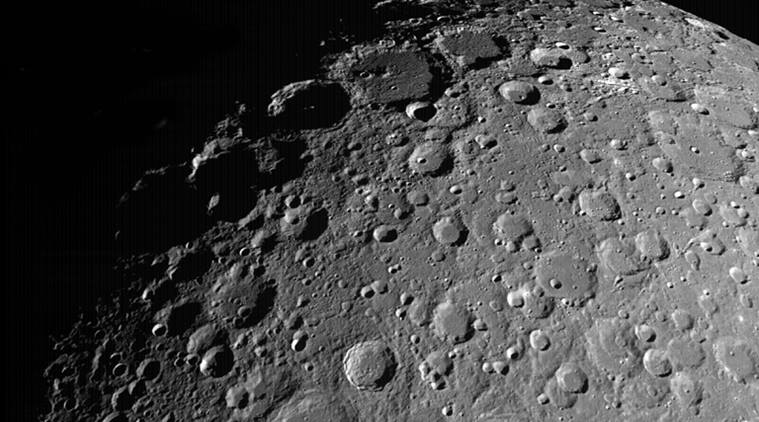Images from ISRO’s Chandrayaan-2: How did craters get names like ‘mitra’?
The first attempts at naming lunar craters date back to the 17th century, K B Shingareva and G A Burba write in their book The Lunar Nomenclature: The Reverse Side of the Moon, 1961-1973.
 The pictures clicked from an altitude of 4,375 km shows impacts craters such as Jackson, Mitra (named after an Indian physicist), Mach and Korolev. (Source: ISRO)
The pictures clicked from an altitude of 4,375 km shows impacts craters such as Jackson, Mitra (named after an Indian physicist), Mach and Korolev. (Source: ISRO)
On Monday, the Indian Space Research Organisation (ISRO) released images of the lunar surface captured from the Chandrayaan-2 spacecraft orbiting the Moon.
Taken on August 23 by the Terrain Mapping Camera-2 of Chandrayaan-2 from an altitude of about 4,375 km, the images show impact craters named after various scientists — (Arnold) Sommerfeld (Germany), (Daniel) Kirkwood (US), (John) Jackson (Scotland), (Ernst) Mach (Austria), (Sergei) Korolev (former USSR), (Sisir) Mitra (India), (John) Plaskett (Canada), (Dmiytry) Rozhdestvenskiy (former USSR) and (Charles) Hermite (France). Mitra (1890-1963), born in Bengal, was a physicist and Padma Bhushan winner.
 The Mitra crater, photographed by Chandrayaan 2, was named after Professor Sisir Kumar Mitra, an Indian physicist and Padma Bhushan recipient. (Source: ISRO)
The Mitra crater, photographed by Chandrayaan 2, was named after Professor Sisir Kumar Mitra, an Indian physicist and Padma Bhushan recipient. (Source: ISRO)
The first attempts at naming lunar craters date back to the 17th century, K B Shingareva and G A Burba write in their book The Lunar Nomenclature: The Reverse Side of the Moon, 1961-1973. Some used the names of prominent personalities — scientists, philosophers and even members of royalty — while others named the lunar features after comparable features on Earth.
The system of nomenclature evolved over the years and is now standardised.
 The North Polar region of the Moon clicked from an altitude of 4,375 km. (Source: ISRO)
The North Polar region of the Moon clicked from an altitude of 4,375 km. (Source: ISRO)
In a resolution by the International Astronomical Union in 1973, crater and crater-like formations are given the names of astronomers or eminent scientists , posthumously.
Among other lunar features, mountains are given names corresponding to the geographical names of mountains of the Earth, while extensive dark surfaces are given names that correspond to the mental states of humans.
- 01
- 02
- 03
- 04
- 05






































